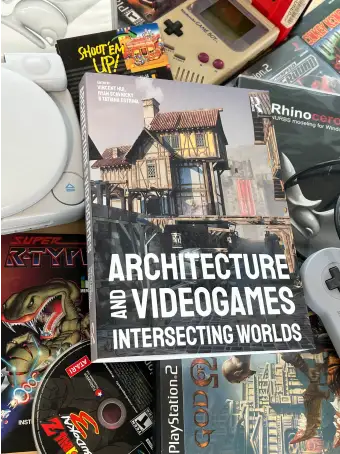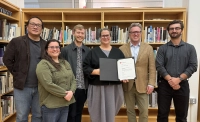.jpg/768w/80q)
Considering a Game Design Degree? Here’s Why You Should Look at Virtual Architecture
Published
A Game Design degree is often an exciting proposal, accompanied by some goofy text like “level up!” While these degrees prepare you for a career in game design, they also limit your ability to explore other opportunities in tech and other design careers. Research shows that the future trajectory of careers in game design, tech, and design in general will be better suited to students who are educated more like architects, who leverage both technical and artistic skills in collaborative ways to complete a project. This was why we launched the Virtual Architecture program at Marywood University right here in Scranton, PA, a brand new path forward to a vast array of careers and possibilities.
Earlier this year, Virtual Architecture Program Coordinator Ryan Scavnicky co-edited the book Architecture and Videogames: Intersecting Worlds which brings together 32 different essays from experts across the fields of architecture and game design to talk about the two converging disciplines.

Virtual Architecture is like an architecture degree for digital worlds. Students spend one and a half years learning the same courses as Architecture and Interior Architecture students, with courses on building technology and architectural history which are bolstered by three semesters of foundational design studio. This course, the design studio, is the most unique part of the program. Each student has their own desk, and spends multiple hours in one week designing a project with the close guidance of a faculty member. During this class, all sorts of exploration can take place, leading to vast amounts of growth, curiosity, and enthusiastic learning. For example, a student might create a space in Minecraft, and bring it to class and use it to present an idea to their instructor!
As the game design industry continues to grow, so do the depth and complexity of games themselves. Most game design degrees are focused on technical skills (usually housed in a college of engineering) or artistic skills (housed in, you guessed it, the college of art). This creates a specialization of graduates unprepared for looking at the bigger picture, so crucial to an overall vision and necessary to achieve both technical and cultural success.
But it isn’t all on screens or in the cloud: The Virtual Architecture program at Marywood University will leverage hands-on learning. For example, students will study how virtual representations of buildings inform the construction industry. This paradigm shift in the industry means that virtual worlds leak out into the world around us, sometimes in an obvious way like the Sphere in Las Vegas, or the OuterNet in London. Knowledge of the physical apparatus of immersive spaces will allow for career flexibility beyond that offered by current game design programs, taking advantage of the application that this technology has to a vastly growing field. Receiving a Bachelor Of Virtual Architecture degree will help you achieve a creatively fulfilling and technically secure career now and into the future.
To learn more about Marywood's Virtual Architecture Program, Request More Information
-
.jpg/200w/99q) Marywood PA Program Brings Holiday Cheer Through Angel Tree Initiative
Marywood PA Program Brings Holiday Cheer Through Angel Tree InitiativeMarywood PA students and faculty, led by Haley Jupina, brought holiday cheer to 94 children through their first-ever Angel Tree initiative—demonstrating the program’s commitment to service and community.
-
 AIA Pennsylvania Honors School of Architecture with 2025 Social Impact Award
AIA Pennsylvania Honors School of Architecture with 2025 Social Impact AwardThis honor is part of the AIA Pennsylvania Architectural Excellence Special Awards program, which recognizes outstanding contributions by individuals, organizations, and institutions that advance the built environment and the architectural profession across the Commonwealth.
-
 Marywood University’s John Maurer to Perform National Anthem at Boston Celtics Game
Marywood University’s John Maurer to Perform National Anthem at Boston Celtics GameJohn Maurer to perform the national anthem at the Boston Celtics game in January